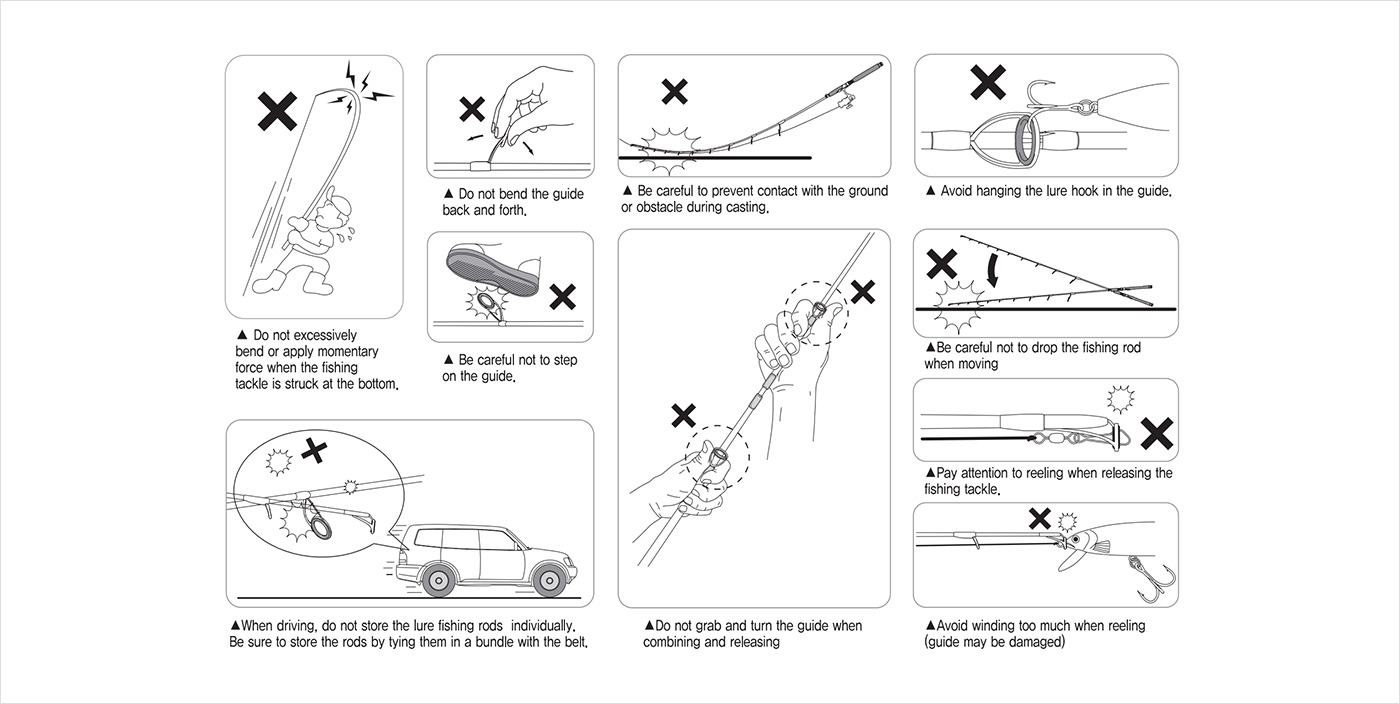HANDLING INFORMATION
Danger
- 1. Be cautious of electric shock from high voltage lines, transmission wires, and cables. Due to their material characteristics, they conduct electricity well. Contact with these wires can lead to electric shock, which in some cases can be fatal. Especially avoid using under high voltage lines, as proximity alone can result in electric discharge leading to shock.
- 2. There have been incidents where fishing rods have come into contact with wires outside designated fishing areas. When using a fishing rod, pay sufficient attention to surrounding safety.
- 3. Beware of electric shock from lightning strikes. If lightning strikes while in use, immediately fold and stow the fishing rod or ensure it falls away from you.
Warning
When casting, please ensure there are no people nearby to confirm safety thoroughly. It's highly dangerous if hooks from fishing rods, lures, or other fishing gear hit someone.
Caution
1. How to Loosen the parts stuck together
To loosen a stuck part of a fishing rod (when the joints are jammed and cannot be removed), apply a rubber sheet or similar material around both sides of the joint to prevent slipping. Then, grasp the rod firmly and twist in opposite directions to loosen the joint. Apply force gradually to avoid the risk of your hands slipping into the rod joints due to sudden force.
2. When snagged
When your lure gets snagged, avoid forcefully pulling or shaking the fishing rod. Instead, ensure the fishing rod and the line are in a straight line, then use your hand to gently pull the line. Shaking the fishing rod forcefully may cause the rod to break and potentially cause injury. Also, when gripping the line with your hand, be cautious of the line cutting into your hand; it's advisable to wrap your hand with gloves or a towel before pulling.
3. Movement and storage of fishing rods
Please handle and transport your fishing rod with care to avoid strong impacts such as hitting or dropping onto hard objects or sharp edges. This is crucial to prevent damage. Carbon fishing rods can break if damage accumulates, even if there is no damage to the surface. Top guides, end rings on interline rods, etc. require special attention.
4.When checking fishing rod action
When testing the action of a fishing rod by attaching weights or bending it by hand, ensure the rod is fully assembled as it would be during actual fishing. Hold the fishing rod grip securely and conduct the test. Do not grip the tip or midsection of the rod. Shaking the rod by gripping the tip can cause damage.
In case of put-in, put-over method
If the joints are not securely inserted, it can lead to damage. However, forcing them in excessively can cause them to jam, so please be careful.
In case of spigot method
In the spigot joint method, there is typically a pre-set allowance of 1 to 1.5cm during coupling. This is not a defect.
Do not sandpaper it down or alter it, as doing so could cause the fishing rod to separate during casting.
In case of telescopic method
Please unfold the fishing rod sections starting from the tip in sequence. Applying excessive force can cause them to jam. Please use gentle force to unfold them. Also, never swing the fishing rod to unfold it, as this can cause it to jam.
When removing the guide cover
When removing the guide cover, please slowly pull it parallel to the fishing rod. Bending or twisting it could damage the tip of the fishing rod.
Be sure to pass the fishing line through all guides.
If you miss any guides while threading the line through, it can exert excessive force on the fishing rod and potentially cause damage. Pay particular attention when passing the line through roller guides and swing rollers.
If it is an interline fishing rod, please follow the instructions.
- Please use the designated fishing wire.
- Avoid using a line with a mid-connection or a knot of thread.
- Ensure the fishing line adheres to the specified size.

